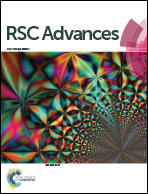Curcumin-derived green plasticizers for poly(vinyl) chloride†
Abstract
The efficient synthesis of curcumin-diesters, which serve as green plasticizers for poly (vinyl) chloride (PVC), is reported. The plasticizers lower the glass transition temperature of PVC, and their cytotoxicity and leaching-resistance properties are significantly better than commercially used phthalate plasticizers which have several limitations.


 Please wait while we load your content...
Please wait while we load your content...